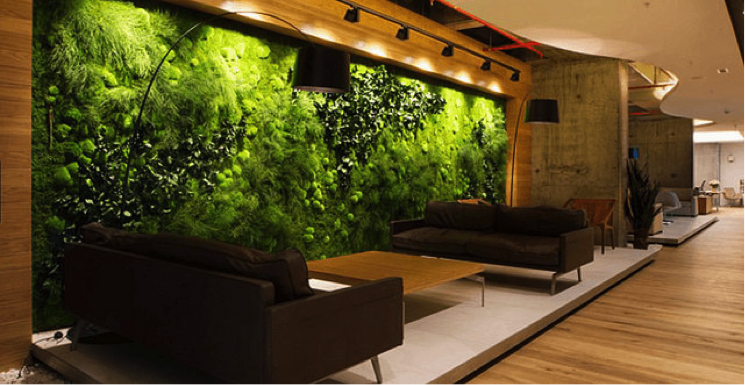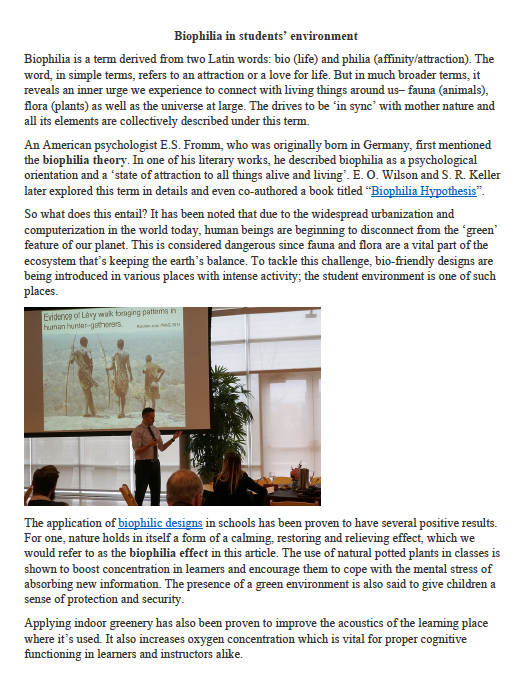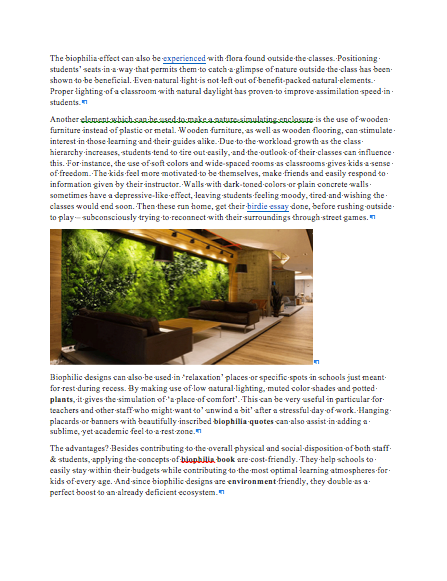
GBE > Encyclopaedia > Code > Issues > G#16587
Biophilic Design Issue
GBE Issue Paper Biophilic Design
About:
Biophilic Design in Student Environments
Biophilia in students’ environment
Biophilia is a term derived from two Latin words: bio (life) and philia (affinity/attraction). The word, in simple terms, refers to an attraction or a love for life. But in much broader terms, it reveals an inner urge we experience to connect with living things around us– fauna (animals), flora (plants) as well as the universe at large. The drives to be ‘in sync’ with mother nature and all its elements are collectively described under this term.
An American psychologist E.S. Fromm, who was originally born in Germany, first mentioned the biophilia theory. In one of his literary works, he described biophilia as a psychological orientation and a ‘state of attraction to all things alive and living’. E. O. Wilson and S. R. Keller later explored this term in details and even co-authored a book titled “Biophilia Hypothesis”.
So what does this entail? It has been noted that due to the widespread urbanization and computerization in the world today, human beings are beginning to disconnect from the ‘green’ feature of our planet. This is considered dangerous since fauna and flora are a vital part of the ecosystem that’s keeping the earth’s balance. To tackle this challenge, bio-friendly designs are being introduced in various places with intense activity; the student environment is one of such places.
The application of biophilic designs in schools has been proven to have several positive results. For one, nature holds in itself a form of a calming, restoring and relieving effect, which we would refer to as the biophilia effect in this article. The use of natural potted plants in classes is shown to boost concentration in learners and encourage them to cope with the mental stress of absorbing new information. The presence of a green environment is also said to give children a sense of protection and security.
Applying indoor greenery has also been proven to improve the acoustics of the learning place where it’s used. It also increases oxygen concentration which is vital for proper cognitive functioning in learners and instructors alike.
The biophilia effect can also be experienced with flora found outside the classes. Positioning students’ seats in a way that permits them to catch a glimpse of nature outside the class has been shown to be beneficial. Even natural light is not left out of benefit-packed natural elements. Proper lighting of a classroom with natural daylight has proven to improve assimilation speed in students.
Another element which can be used to make a nature-simulating enclosure is the use of wooden furniture instead of plastic or metal. Wooden furniture, as well as wooden flooring, can stimulate interest in those learning and their guides alike. Due to the workload growth as the class hierarchy increases, students tend to tire out easily, and the outlook of their classes can influence this. For instance, the use of soft colours and wide-spaced rooms as classrooms gives kids a sense of freedom. The kids feel more motivated to be themselves, make friends and easily respond to information given by their instructor. Walls with dark-toned colours or plain concrete walls sometimes have a depressive-like effect, leaving students feeling moody, tired and wishing the classes would end soon. Then these run home, get their birdie essay done, before rushing outside to play – subconsciously trying to reconnect with their surroundings through street games.
Biophilic designs can also be used in ‘relaxation’ places or specific spots in schools just meant for rest during recess. By making use of low natural lighting, muted color shades and potted plants, it gives the simulation of ‘a place of comfort’. This can be very useful in particular for teachers and other staff who might want to’ unwind a bit’ after a stressful day of work. Hanging placards or banners with beautifully inscribed biophilia quotes can also assist in adding a sublime, yet academic feel to a rest zone.
The advantages? Besides contributing to the overall physical and social disposition of both staff & students, applying the concepts of biophilia book are cost-friendly. They help schools to easily stay within their budgets while contributing to the most optimal learning atmospheres for kids of every age. And since biophilic designs are environment friendly, they double as a perfect boost to an already deficient ecosystem.
Sandra Hayward is a content writer and analyst who has worked closely with school administrators on methods to make learning enjoyable for all ages. She is an accomplished educator and author of numerous valuable articles on learning techniques-related topics.
© Sandra Hayward 2018
© GBE NGS ASWS BrianMurphy
aka BrianSpecMan
6th April 2018
ECH – 13th April 2018
GBE Issue Paper Biophilic Design
Images:



Sandra Hayward GBE Team Member
© Sandra Hayward
© GBE NGS ASWS BrianMurphy
aka BrianSpecMan
6th April 2018 – 13th April 2018
GBE Issue Paper Biophilic Design
See Also:
GBE Issue Papers
GBE Jargon Buster
- Theme:
- Topic
- Biophilia (Jargon Buster) G#16602
- Biophilic
GBE CPD
- Topic
- Greening Your Own Office (CPD) G#261 N#262
GBE Library
- Books
- “Biophilia Hypothesis” Co-Authors: E. O. Wilson and S. R. Keller explored this term in details
GBE Links
E. O. Wilson and S. R. Keller later explored this term in details and even co-authored a book titled “Biophilia Hypothesis”.
GBE Team
Sandra Hayward (Team) G#16622
© GBE NGS ASWS BrianMurphy
aka BrianSpecMan
6th April 2018
ECH – 10th April 2018

